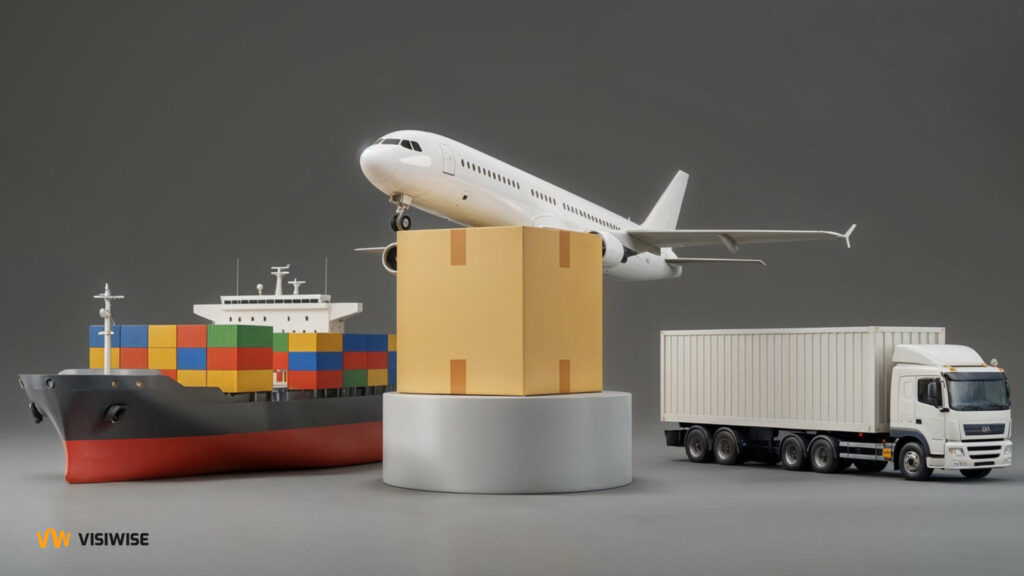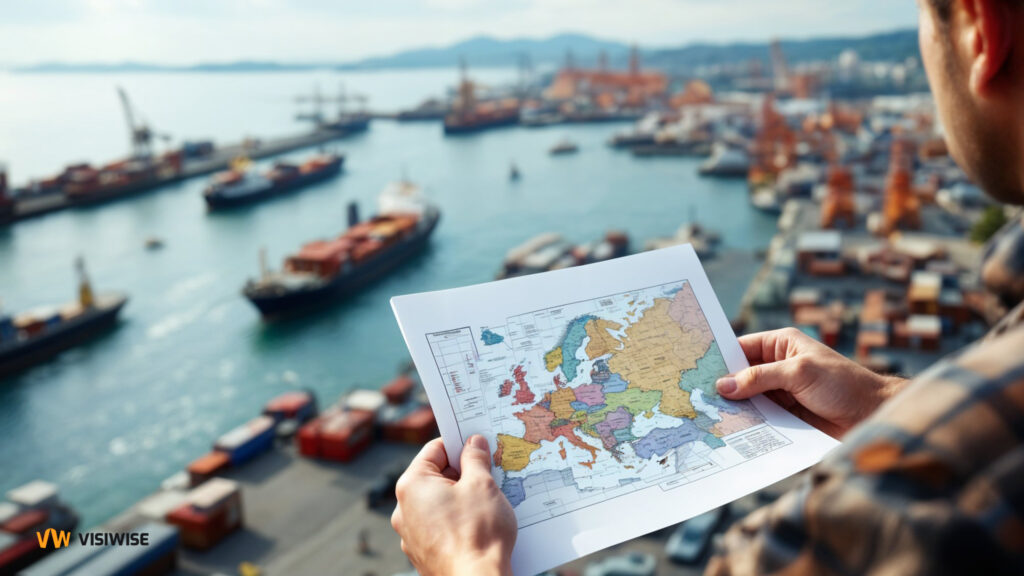China’s rapid industrialization and economic growth have made it a cornerstone in global trade, and its major ports are central to this influence. Spread across the country’s vast coastline and interior, China’s ports support substantial volumes of imports and exports, reinforcing China’s role as a leading player in international commerce. This article explores the key ports in China by region, detailing their significance and contributions to global shipping routes.
How Many Major Ports Are There in China?
China’s port network, a critical driver of its trade dominance, spans across 34 major ports along the eastern and southern coasts and key inland rivers. These ports are classified into three main categories based on their geographic location and role in the national economy: South China Ports, North China Ports, and Central China Ports.
Each of these port clusters serves distinct roles. Some handle high volumes of containerized cargo, while others focus on bulk goods such as coal, ore, or crude oil. Several ports also support passenger and cruise ships, reinforcing China’s status in global maritime transportation. This strategic spread and specialization have allowed China to serve as a pivotal trade partner for top economies, including the United States, the European Union, and Japan.
In examining China’s port infrastructure, we’ll focus on the most significant of these ports, highlighting their contributions to global and regional trade. This selection underscores China’s logistical and economic prowess as a linchpin in the worldwide supply chain.
Port of Shanghai: The World’s Largest Port
The Port of Shanghai is not only the largest port in China but also the busiest in the world in terms of cargo throughput. Strategically located at the Yangtze River Delta, this port handles over 43 million TEUs (Twenty-foot Equivalent Units) annually, a significant portion of which consists of containerized cargo. It has direct shipping lines to major international destinations, making it a vital link in global logistics networks.
Shanghai Port has multiple facilities, including Yangshan Deep-Water Port and the Waigaoqiao Port Area, which help it accommodate the largest container ships and efficiently handle high volumes of goods. The advanced automation systems in place at Shanghai Port allow for streamlined handling processes, enhancing its ability to manage vast trade volumes, and serve major international shipping routes, notably those to North America and Europe.
Key Information
- Workforce Size: 13,546 employees
- Monthly Record for Throughput: 4.20 million TEU
- Total Container Throughput (Yearly): 43.5 million TEU
- Total Cargo Tonnage (Annually): 514 million tons
- Annual Vessel Count: 2,290 ships
- Leading Trade Partners: United States, Japan, Hong Kong, Taiwan, United Kingdom, Germany
- Main Exported Goods: Cars, integrated circuits, computers, telephones
- Primary Imported Goods: Processors and controllers, iron ore concentrate, gold, medium-sized cars
Port of Nantong: China’s Strategic Trade Gateway and Industrial Hub in the Yangtze River Delta
The Port of Nantong, located in Jiangsu Province within the Yangtze River Delta, is a prominent gateway for international trade, linking China with global markets. Situated in the city of Nantong, it plays a pivotal role not only in general trade but also as a hub for China’s oil and gas industry.
The port infrastructure includes a total of 12 port areas, divided into 9 river port areas and 3 coastal port areas. It boasts 88 berths, 65 hectares of yard space, and over 5 hectares dedicated to warehouse storage, supporting high-capacity operations. In 2013, the Port of Nantong achieved a cargo throughput of 205 million metric tons, marking a significant growth of 10.6% compared to 2012.
As one of China’s busiest ports, the Port of Nantong is essential to the nation’s economic trajectory. Its strategic position and capacity provide strong support for ongoing economic growth, and with China’s continued economic expansion, the port is set to experience further development and increased activity in the years to come.
Key Information
- Container Traffic: 600,500 TEUs
- Cargo Volume: 205 million tonnes
- GDP Growth Rate: 8.3%
- Number of Terminals: 88
- Primary Exports: Machinery, textiles, chemicals, agricultural products
- Main Trading Partners: Japan, South Korea, the United States, and the European Union
Port of Nanjing: The World’s Largest Inland Port and Economic Powerhouse in China
The Port of Nanjing, located in Jiangsu Province along the lower reaches of the Yangtze River, holds the title of the world’s largest inland port. Positioned just before the Yangtze River Delta, it oversees 208 kilometers of river shoreline—110 kilometers on the north shore and 98 kilometers on the south shore.
As a primary gateway for international trade and a central hub for domestic shipping, the Port of Nanjing is a critical economic asset for both the city and China as a whole. The port supports a range of major industries, including petroleum, chemicals, and steel, which further strengthens its economic impact. By facilitating trade and driving local employment, the Port of Nanjing is integral to China’s economic growth and to its trade connections with global markets.
Key Information
- Container Traffic: 11.2 million TEUs
- Cargo Volume: 60 million tons
- GDP Growth Rate: 8.5%
- Number of Terminals: 23
- Primary Exports: Machinery, electronics, textiles, chemicals, agricultural products
- Main Trading Partners: Japan, South Korea, the United States, the European Union, and ASEAN countries
Port of Ningbo-Zhoushan: Leading Global Port by Tonnage and Container Capacity
Ningbo-Zhoushan Port, located in China, is the third-largest port globally by container throughput and the largest by tonnage of goods handled. Formed in 2006 through the merger of Ningbo Port and Zhoushan Port, it features a natural deep-water harbor capable of accommodating vessels up to 400,000 DWT. In 2022, the port handled 33.35 million TEUs, securing its position as the world’s third-largest container port, and managed 1.26 billion tons of cargo, marking its 14th consecutive year as the world’s largest port by tonnage.
The port is managed by Zhejiang Provincial Seaport Investment & Operation Group Co. Ltd. (Zhejiang Seaport Group), a largely state-owned enterprise operating over 310 businesses with a workforce of around 30,000. Its core areas include marine resource development, port design and operation, shipping services, storage, bulk commodity processing, and marine engineering. Zhejiang Seaport Group has streamlined port resources across Zhejiang Province, implementing unified planning, branding, and operations to create an integrated operating system and a modern port cluster of global standing.
With a 220-kilometer coastline, Ningbo-Zhoushan Port has 19 port areas and more than 200 large deep-water berths for vessels exceeding 10,000 DWT, including 115 berths designed for vessels over 50,000 DWT. It has one of the highest concentrations of large and super-large deep-water berths in Mainland China. Since 2005, Ningbo-Zhoushan Port has seen a sharp increase in cargo volume. In 2019, it handled 27.535 million TEUs and 1.12 billion tons of cargo, ranking as the world’s leading port by tonnage for the 11th consecutive year.
Key Information
- Container Throughput (2019): 27.535 million TEUs
- Employee Count: 17,425
- Main Trading Partners: European Union, United States, and ASEAN countries
- Total Assets: 124.1 billion Yuan
- Total Import and Export Value: $270.77 billion
- Largest Import: Crude oil, valued at 153.48 billion Yuan
Key South China Ports: Shenzhen, Guangzhou and Hong Kong
Port of Shenzhen
The Port of Shenzhen ranks as one of China’s busiest ports, located in Guangdong Province near Hong Kong. With multiple port areas, such as Yantian, Shekou, and Chiwan, Shenzhen Port is a key hub for South China’s export-oriented economy. The port primarily handles electronic goods, machinery, and textiles, a large portion of which are destined for the U.S. and European markets. Its strategic location makes it ideal for export-driven industries in the Pearl River Delta, and its strong connectivity with over 300 ports worldwide further enhances its significance.
Key Information
- Container Traffic (2018): 27.7 million TEU
- Cargo Tonnage (2018): 194.9 million tons
- Coastline Length: 260 km
- Active Container Lines: 130
- Workforce: 12,454 employees
- Main Exports: Mechanical and electronic products, computers, data processing devices, mobile phones, audio and video equipment
- Total Foreign Trade (Including Imports): 3.45 trillion Yuan
- Primary Ports: Yantian Port, Nanshan Port, and Dachan Bay Port
Port of Guangzhou
The Port of Guangzhou is another major South China port, located in Guangdong Province’s capital. It has a rich history as one of China’s oldest ports and continues to be a bustling trade center today. Guangzhou Port serves both domestic and international markets, with facilities for bulk cargo, containers, and passenger traffic. It plays a critical role in handling goods from South China’s manufacturing hubs, with robust connections to Africa, Southeast Asia, and other parts of Asia. The port’s significant volume of cargo makes it one of the largest in China and one of the most critical in the Pearl River Delta region.
Key Information
- Annual Container Volume: 24.2 million TEUs
- Total Cargo Handled: 600 million tons
- Economic Growth Rate: 8.3%
- Terminal Count: 8
- Leading Exports: Tea, silk, paper, copper, iron, gold, and silver
- Key Trade Partners: United States, Japan, South Korea, Hong Kong, Taiwan, and Thailand
Port of Hong Kong
The Port of Hong Kong, strategically positioned near the South China Sea, is a deep-water seaport that plays a vital role in global trade. Primarily handling the transportation of manufactured goods in containers, the port also sees significant volumes of raw materials and passenger traffic. The natural deep-water harbor of Victoria Harbor is central to Hong Kong’s economic vitality, providing optimal conditions for the docking and servicing of various types of vessels.
Renowned for its bustling maritime activity, the Port of Hong Kong is one of the busiest ports globally. It was once the world’s busiest container port, holding this title from 1987 to 1989, 1992 to 1997, and 1999 to 2004. In 2016, it processed 25,869 container ships, with a combined net registration tonnage of 386,853 tons. The port also features 11 specialized mid-stream yard sites, covering 27.5 hectares of land and extending 3,197 meters along the waterfront.
Key Information
- Container Traffic (2018): 19.6 million TEUs
- Cargo Tonnage (2018): 258.5 million tons
- Land Area: 279 hectares
- Available Berths: 24
- Main Exports: Cement, blank audio media, oscilloscopes, metalworking transfer machines
- Major Imports: Equipment, manufactured goods, chemicals, mineral fuels
- Top Trading Partners: Taiwan, USA, Singapore, South Korea, Japan, Vietnam, India
Port of Xiamen: South-East China’s Major Deep-Sea Gateway
Xiamen, located on the island of Xiamen along the Jiulongjiang River, is a key deep-sea port ranked 17th globally in cargo throughput. It is among the select few ports capable of accommodating mega vessels and sixth-generation ships. The majority of the port is owned by the Xiamen Municipal Government and managed by the Xiamen Port Authority. After merging with the Port of Zhangzhou in 2010, Xiamen became one of the world’s largest ports and is now the largest in South-East China.
The port features 74 berths spread across 12 operational zones, nine of which are designated for container handling. The remaining berths are used for general cargo. These facilities can process up to 10,000 tons of cargo on average, with some able to handle up to 100,000 tons. Spanning 30 kilometers of harbor, the port has an average anchorage depth of 17 meters. Key operational zones include Haitian, Liwudian, Dongdu, and Heping.
Xiamen is equipped with state-of-the-art technology and serves as a hub for major international shipping lines. The port handles nearly 500 vessels each month from over 50 countries, operating 70 routes connecting with key ports across Europe, the Americas, and Africa. Additionally, a passenger ferry service links Xiamen with other mainland ports, including regular services to Hong Kong, Guangzhou, Shanghai, Wenzhou, and Kinmen Island.
Key Information
- Container Traffic (2018): 10.7 million TEUs
- Total Cargo Volume (2018): 218 million tons
- Primary Exports: Tea, salt, graphite powder
- Primary Imports: Wheat, cement, chemical fertilizers, coal, rolled steel, sugar
- Leading Trade Partners: ASEAN, United States, European Union
North China Ports: Tianjin, Dalian, Qingdao, Yingkou and Rizhao
Port of Tianjin
Tianjin Port is the largest port in Northern China and serves as the primary maritime gateway for Beijing. Located in the Bohai Bay, it is strategically positioned to handle imports and exports from the northern regions of China, including Hebei and Shanxi Provinces. Tianjin Port specializes in a range of cargo types, from bulk to containers, and it connects with more than 600 ports worldwide. With its extensive rail and road connections, Tianjin Port facilitates efficient transportation across North China and is instrumental in promoting trade with Japan, South Korea, and Russia.
Key Information
- Container Traffic (2018): 15.97 million TEUs
- Cargo Handled (2018): 428.7 million tons
- Primary Imports: Aircraft (unladen weight), soybeans, electronic integrated circuits, iron ore, medium-sized cars
- Main Exports: Telephones, processors and controllers, bicycles, cargo containers
- Top Trading Partners: United States, Hong Kong, Japan, South Korea, Vietnam, Russia
Port of Dalian
Dalian Port, located in Liaoning Province, is another important port in North China. It is the northernmost ice-free port in China, making it ideal for year-round operations. Dalian Port is known for handling a diverse array of goods, including crude oil, minerals, and containers. The port serves as a critical logistics and trade hub for Northeast China and is also well connected to international destinations across Northeast Asia. Its specialization in petrochemical products and bulk cargo is complemented by its growing container throughput, making it a vital component of China’s northeastern trade infrastructure.
Key Information
- Container Traffic (2018): 9.77 million TEUs
- Cargo Volume (2017): 455 million tons
- Key Trade Partners: Japan, European Union, Saudi Arabia, United States, ASEAN
- Workforce: 11,227 employees
- Main Cargo: Coal (15 million tons)
Port of Qingdao
The Port of Qingdao, located on the Yellow Sea in Shandong Province, China, ranks among the ten busiest ports in the world. In 2011, Qingdao Port formed a strategic alliance with three other Chinese ports and the largest port in South Korea, Busan, to establish a maritime and logistics hub in Northeast Asia. This partnership also includes the ports of Yantai, Rizhao, and Weihai, aiming to enhance regional trade and connectivity.
Qingdao Port is divided into four distinct sections, each with specialized functions. The Dagang and Qianwan sections handle both freight and container traffic. The Qingdao terminal serves international shipping, while Qianwan mainly deals with domestic container shipments. Additionally, the port is equipped with large facilities for managing iron ore cargoes.
Key Information
- Container Traffic (2018): 18.26 million TEUs
- Cargo Tonnage (2018): 600 million tons
- Strategic Alliance: Busan Port, South Korea
- Number of Employees: 9,218
- Major Cargo Handled: Grains, steel products, fertilizers, refined oil, aluminum, frozen products
- Top Trading Partners: ASEAN, United States, European Union
Port of Yingkou
Yingkou Harbor, while one of China’s smaller ports, surpasses the largest ports of many other countries in scale. Managed by the Yingkou Port Group Corporation, this port features 27 berths along with various smaller docks and piers. Yingkou primarily imports grain, coal, steel, and automobiles, while its major exports include foodstuffs, electronics, bulk goods, containerized products, and machinery parts.
The port comprises two main operational areas: the Old Yingkou Port along the Daliao River and Bayuquan Port on the Bohai Sea. Yingkou Harbor offers an array of services to incoming vessels, including loading, pipeline transport, pilotage, communications, and road and rail connections. The Bayuquan container terminal, the port’s primary hub, was developed in collaboration with the China Shipping Corporation (COSCO).
Key Information
- Container Traffic (2018): 6.5 million TEUs
- Cargo Tonnage (2018): 21 million tons
- Primary Imports: Grains, coal, steel, vehicles, oil tar, and minerals
- Primary Exports: Container transshipments
- Key Trade Partners: Japan, South Korea, United States, and European Union
Port of Rizhao
Situated along the southern coast of the Shandong Peninsula, the Port of Rizhao is a significant natural deep-water seaport facing the Yellow Sea. Located in Rizhao, Shandong Province, China, this port comprises two primary areas: the Lanzhou Port Area and the Shijiu Port Area, with a combined total of 46 deep-water berths. In 2012, it managed an impressive 284 million metric tons of cargo, ranking as China’s tenth busiest port.
Rizhao’s strategic position places it near several key cities, with Qingdao to the northeast, Weifang to the north, and Linyi to the west and southwest. Across the Yellow Sea to the east, the port lies directly opposite Korea and Japan, establishing it as a critical gateway for regional trade.
Key Information
- Container Traffic: 1.8 million TEUs
- Cargo Volume: 284 million metric tons
- GDP Growth Rate: 8.5%
- Number of Terminals: 46
- Primary Exports: Iron ore, coal, grain, steel, and cement
- Main Trading Partners: Japan, South Korea, India, Vietnam, and Indonesia
Central China Ports: Wuhan and Chongqing
Port of Wuhan
Located along the Yangtze River, the Port of Wuhan is one of the largest river ports in China and a key inland port. It is strategically positioned in Hubei Province, facilitating trade and transportation for Central China’s industrial base. Wuhan Port primarily handles bulk goods, such as coal, steel, and agricultural products, which are transported from the inland regions to coastal ports for export. The port’s connectivity to Shanghai and other coastal regions allows it to serve as a major transit point, supporting domestic trade and contributing to China’s Belt and Road Initiative.
Key Information
- Container Traffic (2018): Approximately 1.7 million TEUs
- Cargo Tonnage (2018): Over 150 million metric tons
- Main Exports: Steel products, automobiles, machinery, electronics, and chemicals
- Major Imports: Iron ore, crude oil, foodstuffs, and industrial equipment
- Top Trading Partners: Japan, South Korea, United States, Germany, and other regions within China
Port of Chongqing
The Port of Chongqing is located in the mountainous region of Southwest China and is a major port on the upper Yangtze River. Known for its efficient handling of containers and bulk goods, Chongqing Port supports trade in electronics, machinery, and automotive parts. The port connects Central China to international markets, especially in Southeast Asia, through the Yangtze River’s waterway system. Chongqing Port’s importance has grown as China pushes for development in its interior regions, making it an integral part of the country’s inland port network.
Key Information
- Container Traffic (2018): Approximately 1.2 million TEUs
- Cargo Tonnage (2018): Around 125 million metric tons
- Main Exports: Electronics, machinery, chemicals, motorcycles, and agricultural products
- Major Imports: Raw materials (including metals and chemicals), electronics components, and consumer goods
- Top Trading Partners: United States, Japan, European Union, Southeast Asia, and various regions within China
How China’s Ports Influence Global Shipping Routes
China’s ports are at the heart of global shipping routes, and their strategic positioning has transformed the global logistics landscape. The country’s major ports form critical nodes in the Maritime Silk Road, an extension of the Belt and Road Initiative. This vast network not only facilitates trade between China and other countries but also accelerates economic integration across Asia, Europe, and Africa. With direct connections to nearly every corner of the globe, Chinese ports enable rapid transportation of goods, reducing costs and delivery times for international trade partners.
Which Chinese Ports Ship the Most to the US?
The majority of goods shipped from China to the United States originate from three main ports: Shanghai, Shenzhen, and Ningbo-Zhoushan. These ports handle high volumes of electronics, textiles, and machinery, key exports that power China-U.S. trade. Shanghai Port’s advanced automation systems and deep-water berths make it ideal for high-volume shipping, while Shenzhen Port is renowned for its efficiency in handling exports from China’s manufacturing belt. Ningbo-Zhoushan Port’s rapid expansion and excellent handling of bulk cargo also contribute to its leading role in shipping to the U.S. market, ensuring timely and cost-effective delivery.
Conclusion: The Strategic Role of China’s Ports in World Trade
China’s major ports have solidified their position as indispensable hubs in global trade, acting as vital nodes in the interconnected logistics networks that span continents. From the bustling Port of Shanghai, the world’s busiest port, to the inland trade gateways like Wuhan and Chongqing, these ports facilitate a remarkable volume of trade, supporting the nation’s economic growth while shaping the broader global supply chain.
These strategic ports not only serve China’s massive domestic market but also enhance its position as a global leader in trade by providing direct access to key markets across Europe, North America, Asia, and beyond. Ports like Shenzhen and Ningbo-Zhoushan support China’s export-oriented economy, handling a diverse range of goods, from electronics to industrial products, while others, such as Tianjin and Dalian, contribute significantly to the trade infrastructure in the north. As part of China’s ongoing Belt and Road Initiative, these ports strengthen international connectivity, driving economic cooperation and helping to establish China as the cornerstone of global maritime trade.
As China continues to modernize and expand its port infrastructure, its ports will remain at the forefront of international trade. The efficient management, advanced technology, and expanded capacities of these ports position them to respond to the growing demand for global transportation, ensuring that China’s trade links remain robust and competitive. With new technologies, expansion projects, and international collaborations, China’s ports will likely continue shaping global trade dynamics for decades to come, reinforcing the country’s integral role in the worldwide exchange of goods and services.



